|
|
|
| Published
on 20
Dec 2008 |
All rights reserved.
|
|
|
The new 7-Series does not set any
standards in design. It just reverts to conventional style...
|
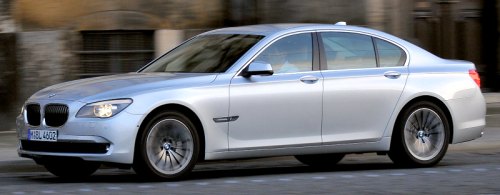 |
The
last generation BMW
7-Series E65 dropped a bombshell to the world in 2001. Although it was
the most technological advanced car then, it took a step perhaps too
far - its controversial design language shocked most BMW
traditionalists, while its overcomplicated i-Drive control system was
seen as a joke by rival engineers. No wonder its worldwide sales never
matched Mercedes S-class. Having learned the lesson, this time BMW is
more cautious in developing the new generation 7-series.
The new car has a new format codename, F01 for regular version or F02
for long wheelbase version. Compare to the last car, its exterior
styling is more conventional, if not conservative. The general body
profile is smoother and easier to eyes. An enlarged double kidney
grille seems going back to the pre-1980s period. It is an effort to
emphasize the brand identity, just like what Audi and Alfa Romeo are
doing to their cars. However, the biggest improvement is the demise of
“Bangle butt” – the pronounced boot lid that sat on the top of the tail
of E65. In the new car, the body lines flow smoothly from the roof to
the boot lid, and the shoulder lines draw straight to the taillights,
all without interrupted by the shut line of boot lid. However, you
don’t need to applause. The new 7-Series does not set any standards in
design. It just reverts to conventional style and no more. Moreover,
its aerodynamic drag coefficient, at 0.30, is poor by the standard of
its class.
The biggest improvement is the demise
of “Bangle butt”...
|
Despite of the call for low emission,
most cars in this luxury class
still grow in size. The new 7-Series is no exception. Its body length
has grown by 30 mm and its wheelbase is 80 mm longer than before (LWB
version gets another 140mm). To compensate, some body panels have been
converted to aluminum, such as bonnet, roof, doors and front fenders,
so the overall weight remains unchanged.
Like the exterior, the cabin has
abandoned the ugly double binnacle
design of the old car and adopted a more conventional dashboard design.
Welcome the back of conventional gearstick (on the transmission tunnel
rather than the steering column). Ditto the slightly driver-orientated
center console, a traditional BMW feature that was lost since Chris
Bangle took charge. As expected, the use of materials and build quality
are first class, although it still lacks the sense of occasion we found
in Mercedes S-class or Bentley. Front and rear space are more than 99
percent people need. Even guys as tall as Yao Ming will find the rear
seats relaxing.
Unsurprisingly, you get whatever luxury and safety features you can
name. First to mention is the second generation i-Drive, which has been
introduced to 3-Series recently. Its menus is finally logically
organized and intuitive to use. Apart from the rotary knob and
selection buttons, it provides additional shortcut keys to CD, Radio,
Telephone and Sat Nav, so no more annoying procedure to select a radio
station or make a call. Other advanced equipment include Night Vision,
blind spot detection, lane departure warning, active cruise control and
HUD (head-up display). The latter now even can display speed limit of
the road on the windscreen. It uses camera to read the road sign and
recognize speed limit, very intelligent, although sometimes the
computer vision could be wrong.
Welcome the back of driver-orientated
center console, a traditional BMW feature that was lost since Chris
Bangle took charge...
|
Back to
the mechanical side, in order
to improve handling, BMW finally
replaced its traditional MacPherson strut front suspensions with a new
double-wishbone design. At the rear, the 5-link suspensions are carried
over. The old 7-Series also donated its long list of sophisticated
electronic suspension aids to this car, such as adaptive damping
(though now can vary both compression and rebound rates), active
anti-roll bars and self-leveling air springs for the rear suspension.
Besides, from the 5-Series it gets Active Steer - the motor-assisted
variable ratio steering.
Moreover, to tell its customers that
itself is more driver-oriented
than anything else in the class, the F01/02 has "Dynamic Drive Control"
- a control system that provides 5 levels of comfort / sport driving
modes for the driver to select. Moreover, these modes change a hell lot
of parameters, i.e., throttle response, gearshift patterns, damping
stiffness, roll resistance, steering weighting, steering ratio and the
threshold of stability control. DDC gives you the convenience that you
don't need to set these parameters individually. Just one button will
do all !
One very important new addition to the
new 7-Series is 4-wheel
steering. This 1980s technology has returned to modern cars since
Nissan Fuga and Skyline (Infiniti M and G series), then extended its
service to Renault Laguna. BMW's system is similar to them. It uses an
electric motor to move the rear wheels up to 3 degrees in opposite
direction to the front wheels at low speed to reduce turning circle,
and in the same direction at high speed lane change to reduce yaw.
All engines are turbocharged,
something you could not have imagined for BMW...
|
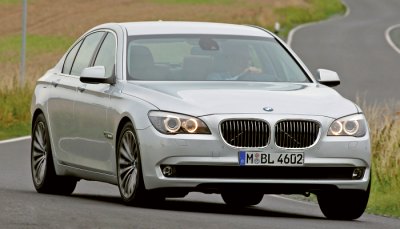 |
Regarding engines, I have two observations. First, BMW reduced the
engine range to only 3 engines - 730d's turbo diesel 3.0 straight-6,
740i's twin-turbo 3.0 straight-6 and 750i's twin-turbo 4.4 V8. This
mean the previous 4.0 V8, 6.0 V12 and 4.4 V8 turbo diesel have been
ditched. It makes more sense to auditors, because the low volume car
does not really need to have 6 engines. The second observation is that
now all engines are turbocharged, something you could not have imagined
for BMW a few years back ! It seems to me that the new thinking of
"Efficient Dynamics" has changed BMW a lot. Undoubtedly, low-pressure
turbocharged engines are more energy efficient than naturally aspirated
ones. They are also very refined by today's technology.
All 3 engines are good ones. 730d is expected to be the best seller in
Europe thanks to its low price and running costs. This engine generates
245 horsepower (up 14hp from last generation) and a useful 398 lb-ft of
torque. It delivers respectable performance (0-60 mph in 6.8 seconds),
good refinement and amazing economy (39.2 mpg combined cycle and
192g/km CO2 emission). It is easily the
most economical car in the luxury class.
Don't fooled by its name, the engine of 740i is not the previous small
V8, but a tuned version of the 3.0 twin-turbo direct injection
straight-6 that powers 335i and 535i. Output increased to 326 hp and
332 lb-ft, comfortably more than the old 4-liter V8 (306 hp and 288
lb-ft). Moreover, its smoothness and eagerness mean few people will
notice the loss of 2 cylinders.
The 750i's twin-turbo 4.4-liter V8 comes straight from BMW X6 (which
was not reported by AutoZine). Compare to the old engine, it lost 400cc
of capacity and Valvetronic, but direct injection and turbocharging are
more than capable to compensate. Horsepower increased from 367 to 408,
while torque is even more encouraging at 442 lb-ft instead of 361
lb-ft. The abundance of torque across a wide band means it is not only
faster than the old 750i, but also faster than the outgoing V12. 0-60
mph now takes 5 seconds flat, faster than Mercedes S500 and Lexus
LS600h. No wonder it makes the old 760Li redundant.
All engines work with the carried over ZF 6-speed automatic
transmission. An 8-speeder is under development.
Still the most driver-oriented car in
the class, but...
|
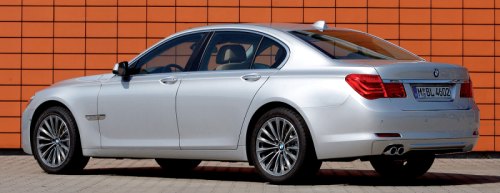 |
On the Road
The new 7-Series is still the most driver-oriented car in the class,
but not as apparent as before. Yes, the 750i combines effortless
performance with good powertrain refinement. The optional 4-wheel
steering does sharpens its low-speed manoeuvrability. Also, the
combination of Dynamic Drive Control, adaptive damping and optional
active anti-roll bars enables remarkably tight body control. But the
basis seems rather ordinary. A standard 730d or 740i without 4WS, DDC
and active anti-roll bars does not have much advantage over rivals, not
particularly agile or involving to drive. Its steering is quick and
accurate but rather lifeless. In the past, good BMW cars were good from
fundamental. They didn't need electronic trickeries to make them right.
Alright, even if you are wealthy enough to tick the top engine and all
necessary options, you still won't get the best car in the class. Why ?
Because the new 7-Series lacks ride comfort and noise suppression to
take on Mercedes S-class and other rivals. While its ride seems smooth
on flat motorway, on less perfect surfaces it delivers some harshness
that you won't expect in the top luxury segment, even with the adaptive
suspension at the softest setting. Again, blame goes to the run flat
tires. On the other hand, cruising at 65 mph or above will hear a lot
of tire roar from underneath and wind noise entering from the
A-pillars. This is not what you would expect for a top luxury car.
Fans of BMW may be glad to learn that it has finally sorted out the
styling and i-Drive of the 7-Series while improving its performance and
efficiency. However, is this really the 7-Series we hoped for ? I'm
afraid not. After 7 years, we should expect another leap in chassis
dynamics and refinement. Unfortunately, it hasn't delivered that.
|
Verdict:     |
| Published
on 11
Sep
2009 |
All rights reserved.
|
|
760Li
|
|
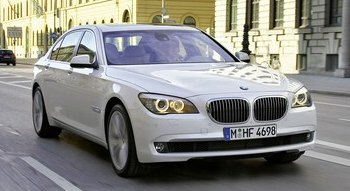 |
The number of cylinders is still a
symbol of wealth and social status in many countries...
|
The
car you see here is the fourth generation V12 7-series. The first one,
as I remember, was born in 1987 under the name 750i (or 750iL for
long-wheelbase version). At that time, the regular 7-series was powered
by no more than a 6-cylinder engine, so as you can imagine, doubling
the cylinder count and increasing horsepower from 220 to 300hp caused a
lot of sensation then. In later years, the regular 7-series evolved to
be more and more powerful, getting V8 engines and eventually twin-turbo
V8, the call for extra power no longer stands. As a result, European
and American sales of the V12 model dropped significantly.
Nevertheless, in developing countries, especially China, Russia and the
Middle East, the number of cylinders is still a symbol of wealth and
social status. The richest people there take up majority sales of 760Li
and Mercedes S600, keeping these absurdly expensive vehicles alive.
The latest 760Li is again a showcase of all the best materials and
technology available at BMW. All option boxes have been ticked,
including an 8-speed automatic gearbox by ZF, adaptive dampers, active
anti-roll bars, air springs, 4-wheel steering and countless of safety
technology that I always fail to remember. It also gets a
long-wheelbase chassis for the boss to stretch his legs, massaging
seats to relieve his fatigue and rear-seat LCD screens to entertain
him.
However, the main point of the car is still its V12 engine. The
previous 760Li employed a naturally aspirated 6-liter V12 good for 445
horsepower and 442 lb-ft of torque. That is no longer sufficient for
the new generation, because the standard 750i already delivers 408 hp
and the same amount of torque. To raise the game while keeping fuel
economy and emission manageable, BMW decided to build a brand new V12.
It shares the same displacement with the old engine, as are
Double-VANOS variable cam phasing and direct injection, but everything
else is different. In particular, it includes a pair of Garrett
turbochargers. Maximum boost pressure is 0.9 bar, while compression
ratio is still a high 10.0:1. Output increased to 544 horsepower and
553 lb-ft of torque. The latter is available from 1500 to 5000 rpm.
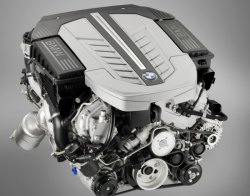
|
Twin-turbo V12 is stronger yet calmer
and less thirsty
|
In order
to
minimize turbo lag, the turbochargers are connected very close to the
exhaust and intake manifolds, so close that they call for an
unconventional indirect intercooling system. The intercoolers are
placed right above the cylinder heads so that they cannot be cooled by
air from the front intakes. Instead, liquid coolant flows into a heat
exchanger, where it is cooled by a secondary cooling circuit which in
turn gets cooled from a front-mounted radiator. This arrangement
enables an unusually short path between fresh air turbine and intake
ports, ensuring very little turbo lag.
As you would expect, on the road the V12 is powerful yet refined. On
the one hand, it runs with creamy smoothness and near silence at any
rev. On the other hand, it has enough punch to propel the car from rest
to 60 mph in 4.4 seconds, the same time as Mercedes S600. Engine
response is quick and lag-free. With strong reserve of power, highway
passing cannot be easier. From 2000 rpm, just a small prod of throttle
will overtake many GTIs at full effort. In addition to the well
insulated cabin and smooth ride, its driver can hardly feel the actual
pace.
The ZF 8-speed automatic making world debut in this car shifts
impeccably. You can hardly tell which gear it is running. Besides, its
low-ratio 8th gear helps fuel economy. BMW claims the car returns 21.8
mpg in European combined cycle, some 4.5 percent better than the less
powerful old car.
Switch the suspensions to Sport or Sport+ mode, you will be amazed by
how well it contains body roll and understeer, and how stable it sweeps
fast corners. The 760Li has handling better than Mercedes S600,
although it doesn't ride as well on poorer surfaces. Still, you can
feel the extra weight at its nose. On tighter roads, the lighter and
shorter 750i will be a better companion.
In the new age of low-carbon economy, do we still need this V12
flagship? No, I suppose not. We would rather have a 750i, which is
fast enough, more fun to drive and a little friendlier to the
environment. If we have million dollars in our bank accounts and want
to show off our wealth, I suppose 760Li is not exclusive enough.
Mercedes S600 looks more graceful in and out, while Bentley Continental
Flying Spur will be another good choice.
|
Verdict:     |
Published
on 12
Dec 2009
|
All rights reserved.
|
|
ActiveHybrid 7
|
|
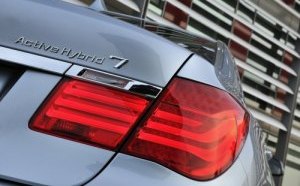
|
The German came late to the party, can
they restore the lost ground ?
|
Lexus
has been selling hybrid luxury cars worldwide since 2006. Initially,
its rivals in Germany did not take that seriously. They doubted the
profitability of hybrid technology and believed clean diesel engines
were the way to go. However, when LS600h successfully established a
superior image in the market, especially in the all-important United
States, they started getting anxious. Fortunately, German component
suppliers, most notably ZF and Continental, committed to develop hybrid
components and systems at full speed. In May 2008, ZF's factory in
Germany started cranking out hybrid drive components for Mercedes S400
Hybrid. It was a disc-type synchronous electric motor capable of
delivering 20 horsepower, sandwiching between the engine and Mercedes'
7-speed automatic transmission to form a mild hybrid. Part of the
pressure was relieved, but the fact that S400 Hybrid cannot match Lexus
for power and performance does not make the German comfortable. This is
what BMW has to respond.
ActiveHybrid 7 ((together with ActiveHybrid X6) is the company's first
hybrid car. It will go on sale in the USA at around US$103,000,
practically the same as Lexus LS600h. It promises to offer superior
performance yet drinking no more fuel and emitting no more
carbon-dioxide.
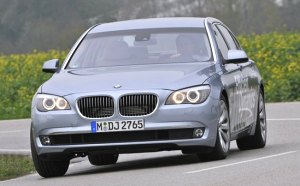
|
Low-end grunt feels more like that of
a supercharged V8 or a big V12...
|
Like the
aforementioned Mercedes, ActiveHybrid 7 is a mild hybrid. Its electric
motor produces only 20hp and 155 lb-ft of torque. This is not strong
enough to power the car alone, but it is useful to boost acceleration,
relieving the load on engine, and to recharge battery during braking.
The disc-type motor is incorporated into the ZF 8-speed automatic
transmission - basically the whole hybrid transmission is supplied by
ZF - again sandwiched between the engine and the torque converter. It
is so compact that occupies virtually the same space as the regular
transmission, so it requires no modifications to the chassis. Not as
clever as S400 Hybrid though, BMW places the Lithium-ion battery at the
boot instead of engine compartment, so luggage space is reduced by 40
liters. Otherwise the car has a package much the same as other 7-series.
Nevertheless, the 4.4-liter gasoline V8 is not exactly the same as
750i's. BMW tweaked its output from 408 hp to 449 hp at 6000 rpm, and
torque from 442 lb-ft to 479 lb-ft from 2000-4500 rpm. As a result,
combined output from the hybrid powertrain is 465 horses and 516
pound-feet. Besides, the aforementioned ZF gearbox has two extra ratios
compared with that of the current 750i. This allows the ActiveHybrid 7
to storm from zero to sixty in 4.7 seconds, raising the eyebrows of
many Porsche drivers. At the same time, fuel economy matches that of
Lexus LS600h, as is the identical CO2
emission of 219 g/km. Compare with the regular 750i, its fuel
consumption is 15 percent lower. Part of the saving is down to the
addition of auto start-stop function to its V8.
On the road, the big hybrid luxury car feels unreasonably fast off the
line, thanks to the electric boost of 155 lb-ft right from idle. The
low-end grunt feels more like that of a supercharged V8 or a big V12.
The car rides and handles like the regular 750i. Only pushing it hard
on winding roads will reveal its weight penalty of 100 kilograms and
the slightly loss of feedback from the steering, which has been
converted to pure electrical assistance. Regenerative braking leads to
soft response over the first few millimeters of brake pedal travel.
Otherwise the ActiveHybrid 7 drives like a slightly faster 750i. The
German may be late to the party, but its first hybrid is a good one,
more accomplished than the Lexus.
|
Verdict:     |
| Published
on 24
Jul
2012 |
All rights reserved.
|
|
7-Series update 2012
|
|
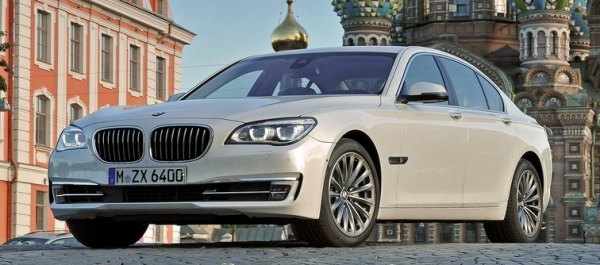
|
The 7-Series has received a
mid-life update. Up front, the bumper has been restyled, accompanied
with a revised kidney grille which has fewer vertical elements.
However, these subtle changes are nowhere comparable to those made to
the mechanical side. 5 out of 7 existing engines have been reworked to
boost power and fuel efficiency simultaneously while one more powerful
diesel engine joins the range. Moreover, all cars finally adopt ZF
8-speed automatic instead of the old 6-speeder. In addition to the
now-default Eco Pro fuel-saving mode, the BMW flagship limousine is far
greener than ever. Below is the summary of all revised engines:
730d: the
3-liter turbo diesel straight-six has its output increased from 245 hp
/ 398 lbft to 258 hp / 413 lbft. It returns a class-leading 50.4 mpg
and 148 grams of CO2 per kilometer, down
17 percent from the old car;
740d:
improved from 306 hp / 443 lbft to 313 hp / 465 lbft. Emission is
reduced by 17 percent as well;
750d xDrive:
this is a new addition to the range. It shares the same tri-turbo
diesel straight-six with M550d
xDrive.
381 horsepower and a spectacular 546 lbft of torque plus a compulsory
4WD system guarantees 0-60 mph in 4.7 seconds only.
740i: it
actually suffers from a slight drop of power, from 326 hp to 320 hp,
thanks to switching from the twin-turbo N54 to single-turbo N55 3.0
straight-six turbo. However, 332 lbft of peak torque is unchanged, and
it is available slightly earlier at 1300 rpm. Valvetronic helps
registering 21 percent of improvement in emission.
750i: as in
6-Series, the new version of 4.4-liter twin-turbo V8 is now equipped
with Valvetronic and its output is pumped up from 408 hp / 442 lbft to
450 hp / 479 lbft. 0-60 mph now takes only 4.6 seconds, while
carbon-dioxide emission is reduced by a remarkable 25 percent to 199
g/km.
ActiveHybrid 7:
the performance-oriented V8 hybrid powertrain has been substituted with
economy-oriented straight-six hybrid, i.e. practically the same unit
powering the smaller ActiveHybrid
5.
The N55 engine produces 320 hp, while an electric motor generates
another 55 hp and 155 lbft to make a system output of 354 hp and 369
lbft. CO2 emission is dramatically
lowered from 219 g/km to 158 g/km as a result, accompanied with a
combined consumption of 41.5 mpg. Performance suffers a little though.
In the chassis, the most important revision is to improve its notorious
ride quality by fitting air suspension at the rear axle as standard,
and by revising rear dampers, bushings, bearings and ball joints. On
the road, the updated car does ride a little smoother on rough
surfaces, but still it can't match a good old Mercedes S-class for ride
comfort. Neither can it match a Jaguar XJ for agility and driver
engagement. This mean the big BMW still fails to leapfrog them in
AutoZine Rating, even though it has the best powertrain lineup in the
class.
|
Verdict:     |
|
|
|
|
|
|
|
|
|
|
730d
|
2008
|
Front-engined,
RWD, 4WS
|
| Steel monocoque |
| Mainly steel |
| 5072 / 1902 / 1479 mm |
| 3070 mm |
Inline-6, diesel
|
| 2993 cc |
DOHC 24 valves
|
VTG turbo
|
| CDI |
245 hp / 4000 rpm
|
398 lbft / 1750-3000 rpm
|
| 6-speed automatic |
F: double-wishbone
R: multi-link
|
Adaptive damping
|
| 245/55ZR17 |
1865 kg
|
| 155 mph (limited) |
6.8 (c) / 6.9*
|
| 17.7* |
|
740d
|
2009
|
Front-engined,
RWD, 4WS
|
| Steel monocoque |
| Mainly steel |
| 5072 / 1902 / 1479 mm |
| 3070 mm |
Inline-6, diesel
|
| 2993 cc |
DOHC 24 valves
|
VTG sequential twin-turbo
|
| CDI |
306 hp / 4400 rpm
|
443 lbft / 1500-2500 rpm
|
| 6-speed automatic |
F: double-wishbone
R: multi-link
|
Adaptive damping
|
| 245/55ZR17 |
1880 kg
|
| 155 mph (limited) |
6.0 (c)
|
| - |
|
740i
|
2008
|
Front-engined,
RWD, 4WS
|
| Steel monocoque |
| Mainly steel |
| 5072 / 1902 / 1479 mm |
| 3070 mm |
Inline-6
|
| 2979 cc |
DOHC 24 valves, DVVT
|
Twin-turbo
|
| DI |
326 hp / 5800 rpm
|
332 lbft / 1500-4500 rpm
|
| 6-speed automatic |
F: double-wishbone
R: multi-link
|
Adaptive damping
|
| 245/50ZR18 |
1860 kg
|
| 155 mph (limited) |
5.6 (c) / 5.1**
|
| 12.8** |
|
|
|
|
|
Performance
tested by: *Autocar, **C&D
|
|
|
|
|
|
|
750i
|
2008
|
Front-engined,
RWD, 4WS
|
| Steel monocoque |
| Mainly steel |
| 5072 / 1902 / 1479 mm |
| 3070 mm |
V8, 90-degree
|
| 4395 cc |
DOHC 32 valves, DVVT
|
Twin-turbo
|
| DI |
408 hp / 5500 rpm
|
442 lbft / 1750-4500 rpm
|
| 6-speed automatic |
F: double-wishbone
R: multi-link
|
Adaptive damping, dampig air springs,
active anti-roll bar
|
245/50ZR18
|
1945 kg
|
| 155 mph (limited) |
5.0 (c) / 5.2* / 4.9**
|
11.9* / 11.3**
|
|
760Li
|
2009
|
Front-engined,
RWD, 4WS
|
| Steel monocoque |
| Mainly steel |
| 5212 / 1902 / 1479 mm |
| 3210 mm |
V12, 60-degree
|
| 5972 cc |
DOHC 48 valves, DVVT
|
Twin-turbo
|
| DI |
544 hp / 5250 rpm
|
553 lbft / 1500-5000 rpm
|
| 8-speed automatic |
F: double-wishbone
R: multi-link
|
Adaptive damping, dampig air springs,
active anti-roll bar
|
245/50ZR18
|
2175 kg
|
| 155 mph (limited) |
4.4 (c) / 4.3*
|
9.6*
|
|
ActiveHybrid
7
|
2009
|
Front-engined,
RWD, 4WS
|
| Steel monocoque |
| Mainly steel |
| 5072 / 1902 / 1479 mm |
| 3070 mm |
V8, 90-degree, electric motor
|
| 4395 cc |
DOHC 32 valves, DVVT
|
Twin-turbo
|
| DI |
465 hp
|
516 lbft
|
| 8-speed automatic |
F: double-wishbone
R: multi-link
|
Adaptive damping, dampig air springs,
active anti-roll bar
|
F: 245/45ZR19
R: 275/40ZR19
|
2045 kg
|
| 155 mph (limited) |
4.7 (c)
|
-
|
|
|
|
|
|
Performance
tested by: *C&D, **R&T
|
|
|
|
|
|
|
730d
|
2012
|
Front-engined,
RWD, 4WS
|
| Steel monocoque |
| Mainly steel |
| 5079 / 1902 / 1471 mm |
| 3070 mm |
Inline-6, diesel
|
| 2993 cc |
DOHC 24 valves
|
VTG turbo
|
| CDI |
258 hp
|
413 lbft
|
| 8-speed automatic |
F: double-wishbone
R: multi-link
|
Adaptive damping
|
| 245/55ZR17 |
1840 kg
|
| 155 mph (limited) |
5.8 (c)
|
| - |
|
740d
|
2012
|
Front-engined,
RWD, 4WS
|
| Steel monocoque |
| Mainly steel |
| 5079 / 1902 / 1471 mm |
| 3070 mm |
Inline-6, diesel
|
| 2993 cc |
DOHC 24 valves
|
VTG sequential twin-turbo
|
| CDI |
313 hp
|
465 lbft
|
| 8-speed automatic |
F: double-wishbone
R: multi-link
|
Adaptive damping
|
| 245/50ZR18 |
1865 kg
|
| 155 mph (limited) |
5.2 (c)
|
| - |
|
750d xDrive
|
2012
|
Front-engined,
4WD
|
| Steel monocoque |
| Mainly steel |
| 5079 / 1902 / 1471 mm |
| 3070 mm |
Inline-6, diesel
|
| 2993 cc |
DOHC 24 valves
|
Sequential Tri-turbo
|
| CDI |
381 hp
|
546 lbft
|
| 8-speed automatic |
F: double-wishbone
R: multi-link
|
Adaptive damping
|
| 245/50ZR18 |
1995 kg
|
| 155 mph (limited) |
4.7 (c)
|
| - |
|
|
|
|
|
| Performance
tested by: - |
|
|
|
|
|
|
740i
|
2012
|
Front-engined,
RWD, 4WS
|
| Steel monocoque |
| Mainly steel |
| 5079 / 1902 / 1471 mm |
| 3070 mm |
Inline-6
|
| 2979 cc |
DOHC 24 valves, DVVT, VVL
|
Turbo
|
| DI |
320 hp / 5800 rpm
|
332 lbft / 1300-4500 rpm
|
| 8-speed automatic |
F: double-wishbone
R: multi-link
|
Adaptive damping
|
| 245/50ZR18 |
1825 kg
|
| 155 mph (limited) |
5.4 (c)
|
| - |
|
750i
|
2012
|
Front-engined,
RWD, 4WS
|
| Steel monocoque |
| Mainly steel |
| 5079 / 1902 / 1471 mm |
| 3070 mm |
V8, 90-degree
|
| 4395 cc |
DOHC 32 valves, DVVT, VVL
|
Twin-turbo
|
| DI |
450 hp / 5500 rpm
|
479 lbft / 2000-4500 rpm
|
| 8-speed automatic |
F: double-wishbone
R: multi-link
|
Adaptive damping, dampig air springs,
active anti-roll bar
|
245/50ZR18
|
1940 kg
|
| 155 mph (limited) |
4.6 (c)
|
-
|
|
ActiveHybrid 7
|
2012
|
Front-engined,
RWD, 4WS
|
| Steel monocoque |
| Mainly steel |
| 5079 / 1902 / 1471 mm |
| 3070 mm |
Inline-6, electric motor
|
| 2979 cc |
DOHC 24 valves, DVVT, VVL
|
Turbo
|
| DI |
354 hp
|
369 lbft
|
| 8-speed automatic |
F: double-wishbone
R: multi-link
|
Adaptive damping
|
| 245/50ZR18 |
1970 kg
|
| 155 mph (limited) |
5.4 (c)
|
| - |
|
|
|
|
|
Performance tested by: -
|
|
|
|
|
|
|
|
|
Copyright©
1997-2012
by Mark Wan @ AutoZine
|
|